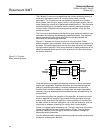
Reference Manual
00809-0100-4697, Rev EA
October 2011
Rosemount 848T
www.rosemount.com
Appendix C FOUNDATION
™
fieldbus
Technology
Overview . . . . . . . . . . . . . . . . . . . . . . . . . . . . . . . . . . . . . . . page C-1
Function Blocks . . . . . . . . . . . . . . . . . . . . . . . . . . . . . . . . . page C-1
Device Descriptions . . . . . . . . . . . . . . . . . . . . . . . . . . . . . . page C-3
Block Operation . . . . . . . . . . . . . . . . . . . . . . . . . . . . . . . . . page C-3
Network Communication . . . . . . . . . . . . . . . . . . . . . . . . . . page C-4
OVERVIEW FOUNDATION fieldbus is an all-digital, serial, two-way, multidrop
communication protocol that interconnects devices such as transmitters,
sensors, actuators, and valve controllers. Fieldbus is a Local Area Network
(LAN) for instruments that are used in both process and manufacturing
automation, having the built-in capability to distribute the control applications
across the network. The fieldbus environment is the base level group of digital
networks and the hierarchy of plant networks.
The F
OUNDATION fieldbus retains the desirable features of the 4–20 mA
analog system, including standardized physical interface to the wire,
bus-powered devices on a single pair of wires, and intrinsic safety options. It
also enables the following capabilities:
• Increased capabilities due to full digital communication.
• Reduced wiring and wire terminations due to multiple devices on one
pair of wires.
• Increased supplier selection due to interoperability
• Reduced loading on control room equipment due to the distribution of
some control and input/output functions to field devices.
F
OUNDATION fieldbus devices work together to provide I/O and control for
automated processes and operations. The Fieldbus F
OUNDATION provides a
framework for describing these systems as a collection of physical devices
interconnected by a fieldbus network. One of the ways that the physical
devices are used is to perform their portion of the total system operation by
implementing one or more function blocks.
FUNCTION BLOCKS Function blocks perform process control functions, such as analog input (AI)
and analog output (AO) functions as well as proportional-integral-derivative
(PID) functions. The standard function blocks provide a common structure for
defining function block inputs, outputs, control parameters, events, alarms,
and modes, and combining them into a process that can be implemented
within a single device or over the fieldbus network. This simplifies the
identification of characteristics that are common to function blocks.


















